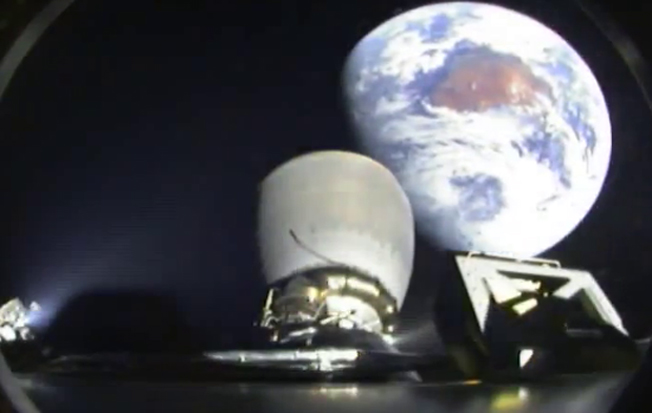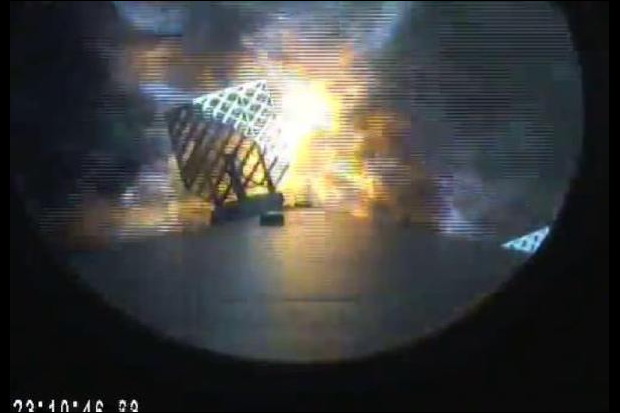SpaceX's 1st Mission to Deep Space Captured in Amazing Photos

A SpaceX rocket launching the spaceflight company's first mission to deep space came in for a smooth landing in the ocean after the launch Wednesday (Feb. 11), as another piece of the rocket captured an incredible view of Earth from space.
SpaceX representatives originally wanted to land the first stage of the Falcon 9 rocket that carried the Deep Space Climate Observatory mission (DSCOVR) to space on a drone ship in the Atlantic Ocean, but rough seas thwarted that attempt. Instead, the Falcon 9 came in for an upright landing in the ocean.
"Rocket soft landed in the ocean within 10m of target & nicely vertical! High probability of good droneship landing in non-stormy weather," SpaceX founder Elon Musk said via Twitter Wednesday. Tests like these may help SpaceX eventually create a fleet of reusable rockets that could dramatically reduce the cost of spaceflight, officials have said. [See more images from the DSCOVR mission]

Before coming in for its landing, the Falcon 9 launched DSCOVR on its way to a point in space 1 million miles (1.6 million kilometers) from Earth called Lagrange 1. The spacecraft will monitor space weather and alert scientists of any potentially harmful solar storms heading toward the planet from that distant orbit. The second stage of the Falcon 9 managed to capture an amazing view of Earth from space during the mission.
You can also watch an amazing video of the Falcon 9's sunset launch of DSCOVR.
The $340 million DSCOVR mission will also produce incredible images of Earth from space during its lifetime. An instrument called EPIC (short for Enhanced Polychromatic Imaging Camera) will beam back pictures of the sunlit side of the planet, an instrument idea that was carried over from an earlier iteration of the satellite, then called Triana.
Triana (sometimes referred to as "GoreSat" due to former Vice President Al Gore's support of the program) was originally approved in 1998, but budget woes and political issues got in the way, forcing officials to mothball the project. The mission was reborn as DSCOVR and as a partnership between NASA, the National Oceanic and Atmospheric Administration (NOAA) and the U.S. Air Force.
Get the Space.com Newsletter
Breaking space news, the latest updates on rocket launches, skywatching events and more!

"It was inspiring to witness the launch of the Deep Space Climate Observatory (DSCOVR)," Gore wrote in a statement posted to his blog after launch. "DSCOVR has embarked on its mission to further our understanding of Earth and enable citizens and scientists alike to better understand the reality of the climate crisis and envision its solutions. DSCOVR will also give us a wonderful opportunity to see the beauty and fragility of our planet and, in doing so, remind us of the duty to protect our only home."
Follow Miriam Kramer @mirikramer. Follow us @Spacedotcom, Facebook and Google+. Original article on Space.com.
Join our Space Forums to keep talking space on the latest missions, night sky and more! And if you have a news tip, correction or comment, let us know at: community@space.com.

Miriam Kramer joined Space.com as a Staff Writer in December 2012. Since then, she has floated in weightlessness on a zero-gravity flight, felt the pull of 4-Gs in a trainer aircraft and watched rockets soar into space from Florida and Virginia. She also served as Space.com's lead space entertainment reporter, and enjoys all aspects of space news, astronomy and commercial spaceflight. Miriam has also presented space stories during live interviews with Fox News and other TV and radio outlets. She originally hails from Knoxville, Tennessee where she and her family would take trips to dark spots on the outskirts of town to watch meteor showers every year. She loves to travel and one day hopes to see the northern lights in person. Miriam is currently a space reporter with Axios, writing the Axios Space newsletter. You can follow Miriam on Twitter.









